| Listing 1 - 10 of 13 | << page >> |
Sort by
|
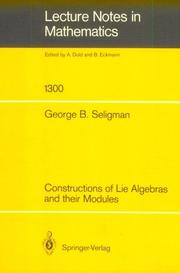
ISBN: 3540189734 3540388648 0387189734 9783540189732 Year: 1987 Volume: 1300 Publisher: Berlin: Springer,
Abstract | Keywords | Export | Availability | Bookmark
 Loading...
Loading...Choose an application
- Reference Manager
- EndNote
- RefWorks (Direct export to RefWorks)
Book
ISBN: 2705657541 9782705657543 Year: 1973 Publisher: Paris : Hermann,
Abstract | Keywords | Export | Availability | Bookmark
 Loading...
Loading...Choose an application
- Reference Manager
- EndNote
- RefWorks (Direct export to RefWorks)
Topological groups. Lie groups --- 512.812 --- Lie groups --- Groups, Lie --- Lie algebras --- Symmetric spaces --- Topological groups --- General Lie group theory. Properties, structure, generalizations. Lie groups and Lie algebras --- Lie groups. --- 512.812 General Lie group theory. Properties, structure, generalizations. Lie groups and Lie algebras --- Lie, Groupes de --- Représentations de groupes de Lie
Book
ISBN: 0691643024 1400853656 9781400853656 9781306988988 1306988985 0691082510 9780691615622 Year: 2014 Publisher: Princeton, NJ : Princeton University Press,
Abstract | Keywords | Export | Availability | Bookmark
 Loading...
Loading...Choose an application
- Reference Manager
- EndNote
- RefWorks (Direct export to RefWorks)
The purpose of this book is to provide a self-contained account, accessible to the non-specialist, of algebra necessary for the solution of the integrability problem for transitive pseudogroup structures.Originally published in 1981.The Princeton Legacy Library uses the latest print-on-demand technology to again make available previously out-of-print books from the distinguished backlist of Princeton University Press. These editions preserve the original texts of these important books while presenting them in durable paperback and hardcover editions. The goal of the Princeton Legacy Library is to vastly increase access to the rich scholarly heritage found in the thousands of books published by Princeton University Press since its founding in 1905.
Lie algebras. --- Ideals (Algebra) --- Pseudogroups. --- Global analysis (Mathematics) --- Lie groups --- Algebraic ideals --- Algebraic fields --- Rings (Algebra) --- Algebras, Lie --- Algebra, Abstract --- Algebras, Linear --- Lie algebras --- Pseudogroups --- 512.81 --- 512.81 Lie groups --- Ideals (Algebra). --- Lie, Algèbres de. --- Idéaux (algèbre) --- Pseudogroupes (mathématiques) --- Ordered algebraic structures --- Analytical spaces --- Addition. --- Adjoint representation. --- Algebra homomorphism. --- Algebra over a field. --- Algebraic extension. --- Algebraic structure. --- Analytic function. --- Associative algebra. --- Automorphism. --- Bilinear form. --- Bilinear map. --- Cartesian product. --- Closed graph theorem. --- Codimension. --- Coefficient. --- Cohomology. --- Commutative ring. --- Commutator. --- Compact space. --- Complex conjugate. --- Complexification (Lie group). --- Complexification. --- Conjecture. --- Constant term. --- Continuous function. --- Contradiction. --- Corollary. --- Counterexample. --- Diagram (category theory). --- Differentiable manifold. --- Differential form. --- Differential operator. --- Dimension (vector space). --- Dimension. --- Direct sum. --- Discrete space. --- Donald C. Spencer. --- Dual basis. --- Embedding. --- Epimorphism. --- Existential quantification. --- Exterior (topology). --- Exterior algebra. --- Exterior derivative. --- Faithful representation. --- Formal power series. --- Graded Lie algebra. --- Ground field. --- Homeomorphism. --- Homomorphism. --- Hyperplane. --- I0. --- Indeterminate (variable). --- Infinitesimal transformation. --- Injective function. --- Integer. --- Integral domain. --- Invariant subspace. --- Invariant theory. --- Isotropy. --- Jacobi identity. --- Levi decomposition. --- Lie algebra. --- Linear algebra. --- Linear map. --- Linear subspace. --- Local diffeomorphism. --- Mathematical induction. --- Maximal ideal. --- Module (mathematics). --- Monomorphism. --- Morphism. --- Natural transformation. --- Non-abelian. --- Partial differential equation. --- Pseudogroup. --- Pullback (category theory). --- Simple Lie group. --- Space form. --- Special case. --- Subalgebra. --- Submanifold. --- Subring. --- Summation. --- Symmetric algebra. --- Symplectic vector space. --- Telescoping series. --- Theorem. --- Topological algebra. --- Topological space. --- Topological vector space. --- Topology. --- Transitive relation. --- Triviality (mathematics). --- Unit vector. --- Universal enveloping algebra. --- Vector bundle. --- Vector field. --- Vector space. --- Weak topology. --- Lie, Algèbres de. --- Idéaux (algèbre) --- Pseudogroupes (mathématiques)
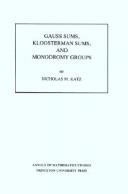
ISBN: 0691084335 0691084327 1400882125 Year: 1988 Volume: vol 116 Publisher: Princeton : Princeton University Press,
Abstract | Keywords | Export | Availability | Bookmark
 Loading...
Loading...Choose an application
- Reference Manager
- EndNote
- RefWorks (Direct export to RefWorks)
The study of exponential sums over finite fields, begun by Gauss nearly two centuries ago, has been completely transformed in recent years by advances in algebraic geometry, culminating in Deligne's work on the Weil Conjectures. It now appears as a very attractive mixture of algebraic geometry, representation theory, and the sheaf-theoretic incarnations of such standard constructions of classical analysis as convolution and Fourier transform. The book is simultaneously an account of some of these ideas, techniques, and results, and an account of their application to concrete equidistribution questions concerning Kloosterman sums and Gauss sums.
Group theory --- Algebraic geometry --- Number theory --- 511.33 --- Analytical and multiplicative number theory. Asymptotics. Sieves etc. --- 511.33 Analytical and multiplicative number theory. Asymptotics. Sieves etc. --- Gaussian sums --- Homology theory --- Kloosterman sums --- Monodromy groups --- Kloostermann sums --- Sums, Kloosterman --- Sums, Kloostermann --- Exponential sums --- Cohomology theory --- Contrahomology theory --- Algebraic topology --- Gauss sums --- Sums, Gaussian --- Analytical and multiplicative number theory. Asymptotics. Sieves etc --- Gaussian sums. --- Kloosterman sums. --- Homology theory. --- Monodromy groups. --- Number theory. --- Nombres, Théorie des. --- Exponential sums. --- Sommes exponentielles. --- Arithmetic --- Arithmétique --- Geometry, Algebraic. --- Géométrie algébrique --- Abelian category. --- Absolute Galois group. --- Absolute value. --- Additive group. --- Adjoint representation. --- Affine variety. --- Algebraic group. --- Automorphic form. --- Automorphism. --- Big O notation. --- Cartan subalgebra. --- Characteristic polynomial. --- Classification theorem. --- Coefficient. --- Cohomology. --- Cokernel. --- Combination. --- Commutator. --- Compactification (mathematics). --- Complex Lie group. --- Complex number. --- Conjugacy class. --- Continuous function. --- Convolution theorem. --- Convolution. --- Determinant. --- Diagonal matrix. --- Dimension (vector space). --- Direct sum. --- Dual basis. --- Eigenvalues and eigenvectors. --- Empty set. --- Endomorphism. --- Equidistribution theorem. --- Estimation. --- Exactness. --- Existential quantification. --- Exponential sum. --- Exterior algebra. --- Faithful representation. --- Finite field. --- Finite group. --- Four-dimensional space. --- Frobenius endomorphism. --- Fundamental group. --- Fundamental representation. --- Galois group. --- Gauss sum. --- Homomorphism. --- Integer. --- Irreducibility (mathematics). --- Isomorphism class. --- Kloosterman sum. --- L-function. --- Leray spectral sequence. --- Lie algebra. --- Lie theory. --- Maximal compact subgroup. --- Method of moments (statistics). --- Monodromy theorem. --- Monodromy. --- Morphism. --- Multiplicative group. --- Natural number. --- Nilpotent. --- Open problem. --- P-group. --- Pairing. --- Parameter space. --- Parameter. --- Partially ordered set. --- Perfect field. --- Point at infinity. --- Polynomial ring. --- Prime number. --- Quotient group. --- Representation ring. --- Representation theory. --- Residue field. --- Riemann hypothesis. --- Root of unity. --- Sheaf (mathematics). --- Simple Lie group. --- Skew-symmetric matrix. --- Smooth morphism. --- Special case. --- Spin representation. --- Subgroup. --- Support (mathematics). --- Symmetric matrix. --- Symplectic group. --- Symplectic vector space. --- Tensor product. --- Theorem. --- Trace (linear algebra). --- Trivial representation. --- Variable (mathematics). --- Weil conjectures. --- Weyl character formula. --- Zariski topology. --- Geometry, Algebraic
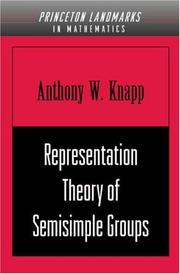
ISBN: 0691090890 9780691090894 0691084017 1400883970 9780691084015 Year: 1986 Volume: 36 Publisher: Princeton (N.J.) : Princeton university press,
Abstract | Keywords | Export | Availability | Bookmark
 Loading...
Loading...Choose an application
- Reference Manager
- EndNote
- RefWorks (Direct export to RefWorks)
In this classic work, Anthony W. Knapp offers a survey of representation theory of semisimple Lie groups in a way that reflects the spirit of the subject and corresponds to the natural learning process. This book is a model of exposition and an invaluable resource for both graduate students and researchers. Although theorems are always stated precisely, many illustrative examples or classes of examples are given. To support this unique approach, the author includes for the reader a useful 300-item bibliography and an extensive section of notes.
Semisimple Lie groups. --- Representations of groups. --- Groupes de Lie semi-simples --- Représentations de groupes --- Semisimple Lie groups --- Representations of groups --- Semi-simple Lie groups --- Lie groups --- Group representation (Mathematics) --- Groups, Representation theory of --- Group theory --- Représentations de groupes --- 512.547 --- 512.547 Linear representations of abstract groups. Group characters --- Linear representations of abstract groups. Group characters --- Abelian group. --- Admissible representation. --- Algebra homomorphism. --- Analytic function. --- Analytic proof. --- Associative algebra. --- Asymptotic expansion. --- Automorphic form. --- Automorphism. --- Bounded operator. --- Bounded set (topological vector space). --- Cartan subalgebra. --- Cartan subgroup. --- Category theory. --- Characterization (mathematics). --- Classification theorem. --- Cohomology. --- Complex conjugate representation. --- Complexification (Lie group). --- Complexification. --- Conjugate transpose. --- Continuous function (set theory). --- Degenerate bilinear form. --- Diagram (category theory). --- Dimension (vector space). --- Dirac operator. --- Discrete series representation. --- Distribution (mathematics). --- Eigenfunction. --- Eigenvalues and eigenvectors. --- Existence theorem. --- Explicit formulae (L-function). --- Fourier inversion theorem. --- General linear group. --- Group homomorphism. --- Haar measure. --- Heine–Borel theorem. --- Hermitian matrix. --- Hilbert space. --- Holomorphic function. --- Hyperbolic function. --- Identity (mathematics). --- Induced representation. --- Infinitesimal character. --- Integration by parts. --- Invariant subspace. --- Invertible matrix. --- Irreducible representation. --- Jacobian matrix and determinant. --- K-finite. --- Levi decomposition. --- Lie algebra. --- Locally integrable function. --- Mathematical induction. --- Matrix coefficient. --- Matrix group. --- Maximal compact subgroup. --- Meromorphic function. --- Metric space. --- Nilpotent Lie algebra. --- Norm (mathematics). --- Parity (mathematics). --- Plancherel theorem. --- Projection (linear algebra). --- Quantifier (logic). --- Reductive group. --- Representation of a Lie group. --- Representation theory. --- Schwartz space. --- Semisimple Lie algebra. --- Set (mathematics). --- Sign (mathematics). --- Solvable Lie algebra. --- Special case. --- Special linear group. --- Special unitary group. --- Subgroup. --- Summation. --- Support (mathematics). --- Symmetric algebra. --- Symmetrization. --- Symplectic group. --- Tensor algebra. --- Tensor product. --- Theorem. --- Topological group. --- Topological space. --- Topological vector space. --- Unitary group. --- Unitary matrix. --- Unitary representation. --- Universal enveloping algebra. --- Variable (mathematics). --- Vector bundle. --- Weight (representation theory). --- Weyl character formula. --- Weyl group. --- Weyl's theorem. --- ZPP (complexity). --- Zorn's lemma.
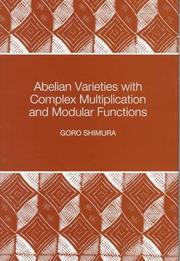
ISBN: 0691016569 1400883946 9780691016566 Year: 1998 Volume: 46 Publisher: Princeton (N.J.): Princeton university press,
Abstract | Keywords | Export | Availability | Bookmark
 Loading...
Loading...Choose an application
- Reference Manager
- EndNote
- RefWorks (Direct export to RefWorks)
Reciprocity laws of various kinds play a central role in number theory. In the easiest case, one obtains a transparent formulation by means of roots of unity, which are special values of exponential functions. A similar theory can be developed for special values of elliptic or elliptic modular functions, and is called complex multiplication of such functions. In 1900 Hilbert proposed the generalization of these as the twelfth of his famous problems. In this book, Goro Shimura provides the most comprehensive generalizations of this type by stating several reciprocity laws in terms of abelian varieties, theta functions, and modular functions of several variables, including Siegel modular functions. This subject is closely connected with the zeta function of an abelian variety, which is also covered as a main theme in the book. The third topic explored by Shimura is the various algebraic relations among the periods of abelian integrals. The investigation of such algebraicity is relatively new, but has attracted the interest of increasingly many researchers. Many of the topics discussed in this book have not been covered before. In particular, this is the first book in which the topics of various algebraic relations among the periods of abelian integrals, as well as the special values of theta and Siegel modular functions, are treated extensively.
Ordered algebraic structures --- 512.74 --- Abelian varieties --- Modular functions --- Functions, Modular --- Elliptic functions --- Group theory --- Number theory --- Varieties, Abelian --- Geometry, Algebraic --- Algebraic groups. Abelian varieties --- 512.74 Algebraic groups. Abelian varieties --- Abelian varieties. --- Modular functions. --- Abelian extension. --- Abelian group. --- Abelian variety. --- Absolute value. --- Adele ring. --- Affine space. --- Affine variety. --- Algebraic closure. --- Algebraic equation. --- Algebraic extension. --- Algebraic number field. --- Algebraic structure. --- Algebraic variety. --- Analytic manifold. --- Automorphic function. --- Automorphism. --- Big O notation. --- CM-field. --- Characteristic polynomial. --- Class field theory. --- Coefficient. --- Complete variety. --- Complex conjugate. --- Complex multiplication. --- Complex number. --- Complex torus. --- Corollary. --- Degenerate bilinear form. --- Differential form. --- Direct product. --- Direct proof. --- Discrete valuation ring. --- Divisor. --- Eigenvalues and eigenvectors. --- Embedding. --- Endomorphism. --- Existential quantification. --- Field of fractions. --- Finite field. --- Fractional ideal. --- Function (mathematics). --- Fundamental theorem. --- Galois extension. --- Galois group. --- Galois theory. --- Generic point. --- Ground field. --- Group theory. --- Groupoid. --- Hecke character. --- Homology (mathematics). --- Homomorphism. --- Identity element. --- Integer. --- Irreducibility (mathematics). --- Irreducible representation. --- Lie group. --- Linear combination. --- Linear subspace. --- Local ring. --- Modular form. --- Natural number. --- Number theory. --- Polynomial. --- Prime factor. --- Prime ideal. --- Projective space. --- Projective variety. --- Rational function. --- Rational mapping. --- Rational number. --- Real number. --- Residue field. --- Riemann hypothesis. --- Root of unity. --- Scientific notation. --- Semisimple algebra. --- Simple algebra. --- Singular value. --- Special case. --- Subgroup. --- Subring. --- Subset. --- Summation. --- Theorem. --- Vector space. --- Zero element.
Book
ISBN: 0691080135 1400869226 Year: 1977 Publisher: Princeton, N.J.
Abstract | Keywords | Export | Availability | Bookmark
 Loading...
Loading...Choose an application
- Reference Manager
- EndNote
- RefWorks (Direct export to RefWorks)
The ∂̄ Neumann problem is probably the most important and natural example of a non-elliptic boundary value problem, arising as it does from the Cauchy-Riemann equations. It has been known for some time how to prove solvability and regularity by the use of L2 methods. In this monograph the authors apply recent methods involving the Heisenberg group to obtain parametricies and to give sharp estimates in various function spaces, leading to a better understanding of the ∂̄ Neumann problem. The authors have added substantial background material to make the monograph more accessible to students.Originally published in 1977.The Princeton Legacy Library uses the latest print-on-demand technology to again make available previously out-of-print books from the distinguished backlist of Princeton University Press. These editions preserve the original texts of these important books while presenting them in durable paperback and hardcover editions. The goal of the Princeton Legacy Library is to vastly increase access to the rich scholarly heritage found in the thousands of books published by Princeton University Press since its founding in 1905.
Partial differential equations --- Neumann problem. --- Neumann problem --- Mathematics --- Physical Sciences & Mathematics --- Calculus --- Boundary value problems --- Differential equations, Partial --- A priori estimate. --- Abuse of notation. --- Analytic continuation. --- Analytic function. --- Approximation. --- Asymptotic expansion. --- Asymptotic formula. --- Basis (linear algebra). --- Besov space. --- Boundary (topology). --- Boundary value problem. --- Boundedness. --- Calculation. --- Cauchy's integral formula. --- Cauchy–Riemann equations. --- Change of variables. --- Characterization (mathematics). --- Combination. --- Commutative property. --- Commutator. --- Complex analysis. --- Complex manifold. --- Complex number. --- Computation. --- Convolution. --- Coordinate system. --- Corollary. --- Counterexample. --- Derivative. --- Determinant. --- Differential equation. --- Dimension (vector space). --- Dimension. --- Dimensional analysis. --- Dirichlet boundary condition. --- Eigenvalues and eigenvectors. --- Elliptic boundary value problem. --- Equation. --- Error term. --- Estimation. --- Even and odd functions. --- Existential quantification. --- Function space. --- Fundamental solution. --- Green's theorem. --- Half-space (geometry). --- Hardy's inequality. --- Heisenberg group. --- Holomorphic function. --- Infimum and supremum. --- Integer. --- Integral curve. --- Integral expression. --- Inverse function. --- Invertible matrix. --- Iteration. --- Laplace's equation. --- Left inverse. --- Lie algebra. --- Lie group. --- Linear combination. --- Logarithm. --- Lp space. --- Mathematical induction. --- Neumann boundary condition. --- Notation. --- Open problem. --- Orthogonal complement. --- Orthogonality. --- Parametrix. --- Partial derivative. --- Pointwise. --- Polynomial. --- Principal branch. --- Principal part. --- Projection (linear algebra). --- Pseudo-differential operator. --- Quantity. --- Recursive definition. --- Schwartz space. --- Scientific notation. --- Second derivative. --- Self-adjoint. --- Singular value. --- Sobolev space. --- Special case. --- Standard basis. --- Stein manifold. --- Subgroup. --- Subset. --- Summation. --- Support (mathematics). --- Tangent bundle. --- Theorem. --- Theory. --- Upper half-plane. --- Variable (mathematics). --- Vector field. --- Volume element. --- Weak solution. --- Neumann, Problème de --- Equations aux derivees partielles --- Problemes aux limites
Book
ISBN: 069108176X 1322884951 1400869307 0691636443 Year: 1978 Publisher: Princeton, N.J.
Abstract | Keywords | Export | Availability | Bookmark
 Loading...
Loading...Choose an application
- Reference Manager
- EndNote
- RefWorks (Direct export to RefWorks)
The classical uniformization theorem for Riemann surfaces and its recent extensions can be viewed as introducing special pseudogroup structures, affine or projective structures, on Riemann surfaces. In fact, the additional structures involved can be considered as local forms of the uniformizations of Riemann surfaces. In this study, Robert Gunning discusses the corresponding pseudogroup structures on higher-dimensional complex manifolds, modeled on the theory as developed for Riemann surfaces.Originally published in 1978.The Princeton Legacy Library uses the latest print-on-demand technology to again make available previously out-of-print books from the distinguished backlist of Princeton University Press. These editions preserve the original texts of these important books while presenting them in durable paperback and hardcover editions. The goal of the Princeton Legacy Library is to vastly increase access to the rich scholarly heritage found in the thousands of books published by Princeton University Press since its founding in 1905.
Analytical spaces --- Differential geometry. Global analysis --- Complex manifolds --- Connections (Mathematics) --- Pseudogroups --- Mathematics --- Physical Sciences & Mathematics --- Calculus --- Global analysis (Mathematics) --- Lie groups --- Geometry, Differential --- Analytic spaces --- Manifolds (Mathematics) --- Adjunction formula. --- Affine connection. --- Affine transformation. --- Algebraic surface. --- Algebraic torus. --- Algebraic variety. --- Analytic continuation. --- Analytic function. --- Automorphic function. --- Automorphism. --- Bilinear form. --- Canonical bundle. --- Characterization (mathematics). --- Cohomology. --- Compact Riemann surface. --- Complex Lie group. --- Complex analysis. --- Complex dimension. --- Complex manifold. --- Complex multiplication. --- Complex number. --- Complex plane. --- Complex torus. --- Complex vector bundle. --- Contraction mapping. --- Covariant derivative. --- Differentiable function. --- Differentiable manifold. --- Differential equation. --- Differential form. --- Differential geometry. --- Differential operator. --- Dimension (vector space). --- Dimension. --- Elliptic operator. --- Elliptic surface. --- Enriques surface. --- Equation. --- Existential quantification. --- Explicit formula. --- Explicit formulae (L-function). --- Exterior derivative. --- Fiber bundle. --- General linear group. --- Geometric genus. --- Group homomorphism. --- Hausdorff space. --- Holomorphic function. --- Homomorphism. --- Identity matrix. --- Invariant subspace. --- Invertible matrix. --- Irreducible representation. --- Jacobian matrix and determinant. --- K3 surface. --- Kähler manifold. --- Lie algebra representation. --- Lie algebra. --- Line bundle. --- Linear equation. --- Linear map. --- Linear space (geometry). --- Linear subspace. --- Manifold. --- Mathematical analysis. --- Mathematical induction. --- Ordinary differential equation. --- Partial differential equation. --- Permutation. --- Polynomial. --- Principal bundle. --- Projection (linear algebra). --- Projective connection. --- Projective line. --- Pseudogroup. --- Quadratic transformation. --- Quotient space (topology). --- Representation theory. --- Riemann surface. --- Riemann–Roch theorem. --- Schwarzian derivative. --- Sheaf (mathematics). --- Special case. --- Subalgebra. --- Subgroup. --- Submanifold. --- Symmetric tensor. --- Symmetrization. --- Tangent bundle. --- Tangent space. --- Tensor field. --- Tensor product. --- Tensor. --- Theorem. --- Topological manifold. --- Uniformization theorem. --- Uniformization. --- Unit (ring theory). --- Vector bundle. --- Vector space. --- Fonctions de plusieurs variables complexes --- Variétés complexes

ISBN: 0691082286 0691082324 1400881579 Year: 1979 Publisher: Princeton, N.J.
Abstract | Keywords | Export | Availability | Bookmark
 Loading...
Loading...Choose an application
- Reference Manager
- EndNote
- RefWorks (Direct export to RefWorks)
Based on a seminar sponsored by the Institute for Advanced Study in 1977-1978, this set of papers introduces micro-local analysis concisely and clearly to mathematicians with an analytical background. The papers treat the theory of microfunctions and applications such as boundary values of elliptic partial differential equations, propagation of singularities in the vicinity of degenerate characteristics, holonomic systems, Feynman integrals from the hyperfunction point of view, and harmonic analysis on Lie groups.
Mathematical analysis --- Differential geometry. Global analysis --- 517.98 --- -Advanced calculus --- Analysis (Mathematics) --- Algebra --- Functional analysis and operator theory --- Addresses, essays, lectures --- Mathematical analysis. --- Addresses, essays, lectures. --- -517.1 Mathematical analysis --- 517.98 Functional analysis and operator theory --- -Functional analysis and operator theory --- -517.98 Functional analysis and operator theory --- 517.1 Mathematical analysis --- 517.1. --- 517.1 --- Addition. --- Analytic function. --- Analytic manifold. --- Asymptotic analysis. --- Bernhard Riemann. --- Boundary value problem. --- Bounded operator. --- Cartan subgroup. --- Characterization (mathematics). --- Class function (algebra). --- Closed-form expression. --- Codimension. --- Cohomology. --- Compact space. --- Comparison theorem. --- Contact geometry. --- Continuous function. --- Continuous linear operator. --- Convex hull. --- Cotangent bundle. --- D-module. --- Degenerate bilinear form. --- Diagonal matrix. --- Differentiable manifold. --- Differential operator. --- Dimension (vector space). --- Dimension. --- Elliptic partial differential equation. --- Equation. --- Existence theorem. --- Fourier integral operator. --- Generic point. --- Group theory. --- Harmonic analysis. --- Holomorphic function. --- Holonomic. --- Homogeneous space. --- Hyperfunction. --- Hypersurface. --- Identity element. --- Irreducible representation. --- Killing form. --- Lagrangian (field theory). --- Lie algebra. --- Lie group. --- Linear differential equation. --- Locally compact space. --- Masaki Kashiwara. --- Maximal ideal. --- Monodromy. --- Natural number. --- Neighbourhood (mathematics). --- Ordinary differential equation. --- Orthogonal complement. --- Partial differential equation. --- Path integral formulation. --- Proper map. --- Pseudo-differential operator. --- Regularity theorem. --- Sigurdur Helgason (mathematician). --- Submanifold. --- Subset. --- Summation. --- Symmetric space. --- Symplectic geometry. --- Tangent cone. --- Theorem. --- Topological space. --- Vector bundle. --- Victor Guillemin. --- Weyl group. --- Analyse microlocale
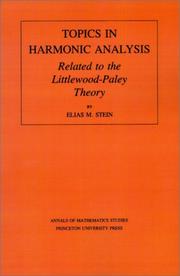
ISBN: 0691080674 1400881870 9780691080673 Year: 1970 Volume: 63 Publisher: Princeton, N.J.: Princeton university press,
Abstract | Keywords | Export | Availability | Bookmark
 Loading...
Loading...Choose an application
- Reference Manager
- EndNote
- RefWorks (Direct export to RefWorks)
This work deals with an extension of the classical Littlewood-Paley theory in the context of symmetric diffusion semigroups. In this general setting there are applications to a variety of problems, such as those arising in the study of the expansions coming from second order elliptic operators. A review of background material in Lie groups and martingale theory is included to make the monograph more accessible to the student.
Harmonic analysis. Fourier analysis --- Harmonic analysis --- Semigroups --- 517.986.6 --- Lie groups --- Littlewood-Paley theory --- #WWIS:d.d. Prof. L. Bouckaert/BOUC --- Fourier analysis --- Functions of several real variables --- Group theory --- Groups, Lie --- Lie algebras --- Symmetric spaces --- Topological groups --- Analysis (Mathematics) --- Functions, Potential --- Potential functions --- Banach algebras --- Calculus --- Mathematical analysis --- Mathematics --- Bessel functions --- Fourier series --- Harmonic functions --- Time-series analysis --- Harmonic analysis of functions of groups and homogeneous spaces --- Harmonic analysis. --- Littlewood-Paley theory. --- Lie groups. --- Semigroups. --- 517.986.6 Harmonic analysis of functions of groups and homogeneous spaces --- Addition. --- Analytic function. --- Axiom. --- Boundary value problem. --- Central limit theorem. --- Change of variables. --- Circle group. --- Classification theorem. --- Commutative property. --- Compact group. --- Complex analysis. --- Convex set. --- Coset. --- Covering space. --- Derivative. --- Differentiable manifold. --- Differential geometry. --- Differential operator. --- Dimension (vector space). --- Dimension. --- Direct sum. --- E6 (mathematics). --- E7 (mathematics). --- E8 (mathematics). --- Elementary proof. --- Equation. --- Equivalence class. --- Existence theorem. --- Existential quantification. --- Fourier analysis. --- Fourier series. --- Fourier transform. --- Function space. --- General linear group. --- Haar measure. --- Harmonic function. --- Hermite polynomials. --- Hilbert transform. --- Homogeneous space. --- Homomorphism. --- Ideal (ring theory). --- Identity matrix. --- Indecomposability. --- Integral transform. --- Invariant measure. --- Invariant subspace. --- Irreducibility (mathematics). --- Irreducible representation. --- Lebesgue measure. --- Legendre polynomials. --- Lie algebra. --- Lie group. --- Linear combination. --- Linear map. --- Local diffeomorphism. --- Markov process. --- Martingale (probability theory). --- Matrix group. --- Measurable function. --- Measure (mathematics). --- Multiple integral. --- Normal subgroup. --- One-dimensional space. --- Open set. --- Ordinary differential equation. --- Orthogonality. --- Orthonormality. --- Parseval's theorem. --- Partial differential equation. --- Probability space. --- Quadratic form. --- Rank of a group. --- Regular representation. --- Riemannian manifold. --- Riesz transform. --- Schur orthogonality relations. --- Scientific notation. --- Semigroup. --- Sequence. --- Special case. --- Stone–Weierstrass theorem. --- Sturm–Liouville theory. --- Subgroup. --- Subset. --- Summation. --- Tensor algebra. --- Tensor product. --- Theorem. --- Theory. --- Topological group. --- Topological space. --- Torus. --- Trigonometric polynomial. --- Trivial representation. --- Uniform convergence. --- Unitary operator. --- Unitary representation. --- Vector field. --- Vector space. --- Lie, Groupes de --- Analyse harmonique
| Listing 1 - 10 of 13 | << page >> |
Sort by
|

 Search
Search Feedback
Feedback About UniCat
About UniCat  Help
Help News
News